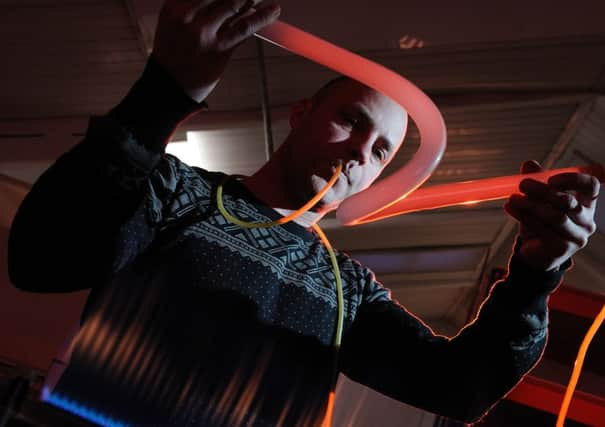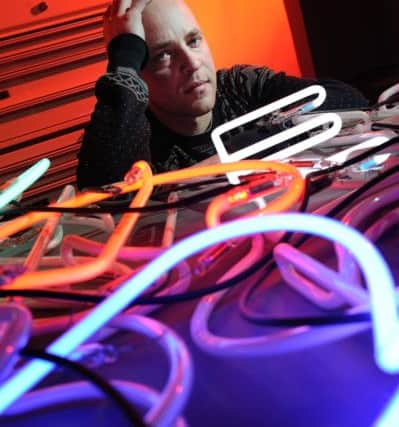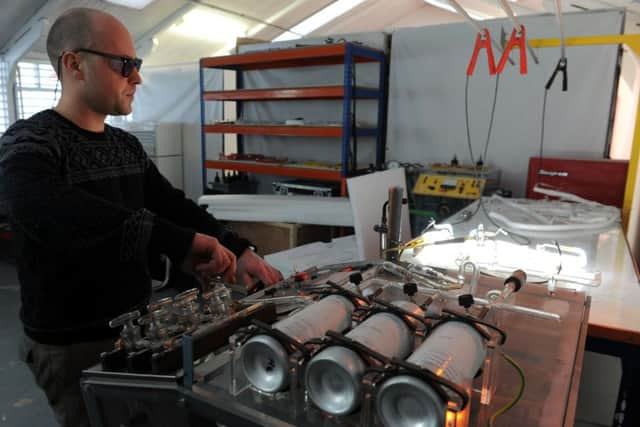It’s a gas: Making light work of art


Here’s something you probably won’t know: neon, that brightest of glows, was first shown in a bad light in the film It’s A Wonderful Life.
Yes, that wholesome, seasonal favourite chose to depict a town gone bad by covering it in huge, pulsating neon signs. The message was clear – neon is a symbol for all that is seedy. Its garish light decorates the buildings on the wrong side of the tracks. Until then, neon had been all about the glamour.
Advertisement
Hide AdAdvertisement
Hide AdI didn’t know that until I met Richard Wheater, an artist based in Wakefield, who knows pretty much all there is to know about neon and can chart its history from the glory days of the early 1900s. It was a British invention but first used for advertising in Paris in 1912 and it soon found its way, as most thing do, to America.


There, the inhabitants of Los Angeles took one look and declared themselves impressed. It was like fire being trained inside glass, they said.
After that, well, its image tarnished, but there is no doubt that neon has wow factor – and these days is on the up again. Richard is keen for us to understand its range and versatility. He said: “People always think of neon as this garish thing, but it can be subtle, in colours like white and beige. It doesn’t have to be shades of red.”
For more than a decade, the 36-year-old has made it his business to turn the image of neon from something that has all the subtlety of a flying mallet into a more imaginative art from.
Advertisement
Hide AdAdvertisement
Hide AdAnd he has become an expert in his field, not only creating works of art but teaching other people about neon too, from absolute beginners to fellow artists. He operates from a little workshop up a back street in the industrial part of Wakefield, near the railway track – but people from all over the world come there to learn his craft.


He has had clients from America, Australia, New Zealand, South Africa and all over Europe attend his four-day intensive workshops. On his one-day courses, run with qualified engineer and commercially trained neon expert Julia Bickerstaff, he attracts a varied crowd: a priest, a long distance lorry driver, and a builder have been among the professions represented.
They come to Richard because he is good, but also because he is the only person in Europe offering this creative knowledge about neon. There are no other training courses. And he has worked far and wide himself, living in Edinburgh, New York and Seattle before settling in Wakefield because West Yorkshire, it turns out, is a rare hot spot for the manufacture of neon lighting, which is ironic because it is where Richard grew up.
He said: “I had no idea that it was a Yorkshire industry when I first became interested. I was in New York learning about it and my tutor said he got all his equipment from a place called Leeds in England.”
Advertisement
Hide AdAdvertisement
Hide AdBut, let’s get down to basics, and run through exactly what neon is. Well, fascinating is what it is. Neon is a gas and it is in the air we breathe.
When it is captured inside a glass vacuum and an electric current run through it, it glows vibrant red. Red is its natural colour, which is why so many neon signs are red.
And for something that is unbelievably bright it uses very little electricity, making it an environmentally kind and cost-effective choice of illumination.
Once Richard begins to explain the nature of neon gas and the way it is turned into light, he starts to sound less like an artist and more like a mad scientist.
Advertisement
Hide AdAdvertisement
Hide AdThe equipment in his studio adds to the impression. It is large and dramatic. There is something called an electron bombarder – they cost £24,000 to buy new, so Richard spent a year making one of his own, in and amongst his other work.
Then there is the way he switches seamlessly into talking amps and milliamps and voltage, in amongst the flame and wires light. Neon is a combination of science, industry and magic.
Richard said: “It is a loaded media, associated with the seedy side of urban life, but it is very much misunderstood. Some local authorities want to be neon-free but it has many advantages over LED lighting, for instance.
“It is virtually maintenance free, it lasts for decades and it is high voltage so really bright but needs a tiny amount of electricity to run. It can use milliamps, so less than an amp.”
Advertisement
Hide AdAdvertisement
Hide AdThe basic process for creating a neon artwork is this: Richard takes a glass tube and heats it over a demonic looking type of Bunsen burner until it is soft enough to shape.
He doesn’t need to wear gloves because glass is such a poor conductor of heat. Then it is over to the electron bombarder which he uses to draw out the air from the glass, create a vacuum and fill it with gas.
Then he puts an electric charge through it and – voila – a neon light burns bright. There’s more to it, of course.
The gas can be changed into an infinite number of colours and shades by adding other gasses.
Advertisement
Hide AdAdvertisement
Hide AdOr the glass can simply be coloured, but that’s expensive and Richard doesn’t favour it all that much.
Nothing in Richard’s background suggested he would be an artist, much less working in this unusual medium. His father was a plasterer and his mother was a clerk on a maternity ward, although helping his father in the holidays did develop his hand/eye coordination, he says.
His parents did not want him to go to art college, but he did it anyway, taking a course at Batley art college and going on to Sunderland University where his first interest was not neon, but glass.
“I loved Leeds. It was in the mid-90s when the city was beginning to boom. I would look out of the window as my train was pulling in and see all this glass in the new buildings and it created an interest.”
Advertisement
Hide AdAdvertisement
Hide AdEventually he went to study in Edinburgh and was introduced to neon, and from there went to America to learn more, but in 2006 he came back to England.
“In New York a tutor told me to check out these guys in Leeds, so after living in Seattle and New York I came back to Wakefield and trained in Leeds at a commercial neon company.”
In 2010 he felt ready to open his own creative studio and workshop, which has been a huge success.
Richard, who is single and lives in an apartment in Wakefield centre, has staged several exhibitions and sold pieces of work for thousands of pounds. He exhibited in Damien Hirst’s London gallery and sold a piece called I’m Electric, You’re Electric for £7,500.
Advertisement
Hide AdAdvertisement
Hide AdRichard sees neon not as retro but as part of the future, but he is happy to help restore vintage pieces. While I am visiting his studio, builder David Leake, of Barnsley, calls in to collect an old neon Coca-Cola sign that Richard has repaired for him.
He bought it at auction for £60 three years ago and now intends to hang it on the wall of the kitchen diner in the new house he is building for his family.
“My daughter Annabel spotted it and told me. After I bought the sign we found out about Richard and the whole family came on one of the day courses here to find out more about it, then I asked if he could repair the sign I had.
“I love these old signs and I think it is marvellous that Richard can bring them back to life.”
Advertisement
Hide AdAdvertisement
Hide AdOne of Richard’s best known exhibitions was called 12 Months of Neon Love when he and fellow artist Victoria Lucas made one neon sign per month for a year featuring lyrics of well known love songs, and installed them as great billboards on the side of the workshop for all the city and the passing train passengers to see.
The lyrics came from great artists through pop history, from Elvis to Joy Division, and the project created a huge buzz before it ended on Valentine’s Day 2012.
Another event was a mobile workshop called Northern Lights, held in Reykjavik, Iceland.
Now Richard has many more plans. His latest exhibition, Beautiful Hazards, is currently on display at his workshop and he has other projects besides, one of them being Wakefield’s Artwalk, which he set up after witnessing something similar in Seattle.
Advertisement
Hide AdAdvertisement
Hide AdHe said: “Wakefield is synonymous with drinking culture, with the pub crawl, but I find the interest in art in this city amazing.
And he is currently seeking backing through Kickstarter to fund a three day pop-up exhibition in New York collaborating with two other Wakefield artists, Andy Singleton and Richard Sweeney, on a show called Nude not Naked, which explores the human form.
But his main work remains neon, which Richard believes has come full circle. In its heyday between the wars, it was seen as glamorous and elegant, then it became part of the glitz and brashness of Las Vegas before being seen as the emblem of the run down, cheap side of town.
Now it is fashionable again, almost to the point of concern: “Neon goes for auction sometimes for huge amounts of money. It is cool again and actually that makes me worry that the bubble will burst.
Advertisement
Hide AdAdvertisement
Hide Ad”But one thing you can say about neon is that it is always entertaining, it makes you smile.”
Beautiful Hazards is on display at Neon Workshops, 70 George Street, Wakefield, WF1 1DL, until March 15. Visit www.neonworkshops.com
• Find out more about Nude not Naked at https://www.kickstarter.com/projects/1086863365/nude-not-naked